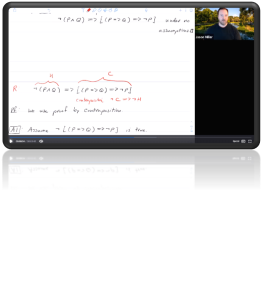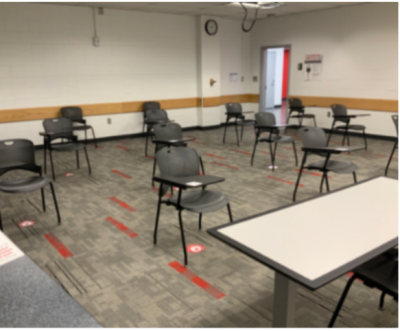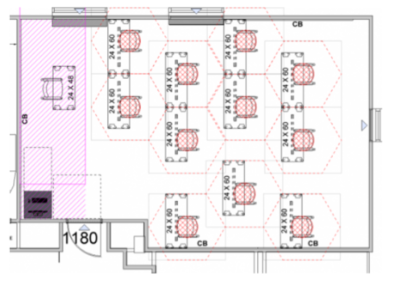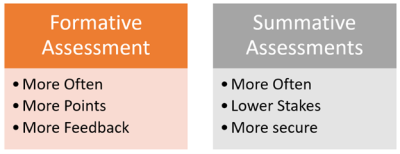Elizabeth Miller
Introduction
The sudden switch to online instruction in spring 2020 due to the COVID-19 pandemic presented a unique challenge to educators everywhere, and the Department of Mathematics at Ohio State was no exception. The instructors in our department, with the support of the Mathematics and Statistics Learning Center (MSLC) and other teaching and technology resources at Ohio State, did a truly remarkable job of moving over 300 classes online in an exceptionally short time. With time to prepare for autumn 2020, we wanted to continue improving our online courses and introduce hybrid courses. A plan was developed to implement several major changes in autumn 2020, including:
- Holding Live (Synchronous) Classes
- Rethinking Assessments
- Actively Engaging Students
- Robust Instructor Support
Each of these changes presented both challenges and opportunities.
Holding Live Classes
Rather than opting for asynchronous recorded videos, in autumn the department held synchronous classes where instructors and students interacted in real time. Classes were held in a variety of formats to accommodate student needs: online, hybrid and in-person.

Online class sessions were held in CarmenZoom, Ohio State’s instance of Zoom. Instructors used iPads with Apple Pencils or document cameras to show their handwriting during class. They were also able to show their face using a webcam to help students connect with them. Online classes varied from webinars with hundreds of students to small discussion sessions, but in all cases, instructors used digital tools to interact with students in real time. For example, students used a Q&A tool in webinars to vote up each other’s questions. Some instructors asked questions to students using the polling or chat tools. In other courses, students were split into groups to work together solving math problems using Zoom Breakout Rooms and a common digital whiteboard; instructors of these courses hopped from group to group to answer questions and provide scaffolding.
Hybrid classes included multiple arrangements where a portion of the class was in-person and a portion was online. One such arrangement, called the cohort model, was used for approximately half of the recitation classes in large, first- and second-year math courses (The other recitation sections of these classes were entirely online.) In the cohort model, students in a recitation were subdivided into smaller groups, and each group was assigned a day of the week in which they attended in person. On remaining class days, students joined the in-person class remotely through Zoom. In these classes, TAs taught using document cameras that streamed to Zoom and the classroom projector simultaneously. Due to social distancing requirements, most classrooms on campus held less than 20 students at a time. The cohort model allowed more students to have in-person instruction despite the limited pool of larger classrooms.


Even in-person classes changed from earlier semesters. Students sat 6 feet apart, instructors were confined to an instructor zone at the front of the classroom and everyone wore masks. Instructors of in-person classes needed to be able to quickly respond to multiple scenarios such as quarantined students or a sudden switch back to online-only instruction. As a result, many in-person classes were also streamed and/or recorded using Zoom so students could participate remotely.
Rethinking Assessments

There are many reasons why traditional approaches to assessment needed to be rethought during these unusual times. Paper assessments were impractical because papers can be vectors for disease, so assessments needed to be digital. Students needed more feedback on assignments because it was more difficult for them to ask about what they missed. There were also concerns about academic integrity in the online environment. In redesigning assessments, we strived to ensure classes were fair and assessments helped guide and motivate student learning.
When moving our math assessments online, we made changes to increase formative assessment opportunities while making summative assessments lower stakes and more secure. These changes took place differently in different courses. Some classes lowered the stakes of exams by employing more frequent but smaller exams, exam corrections, group-based assignments and/or alternatives to exams such as portfolios. To help make exams more secure, instructors implemented time limits on online exams, asked students to submit their handwritten work, used multiple versions of exams, asked open-ended questions where student solutions look different from one another and in some instances used online proctoring software. Instructors employed multiple technology systems such as CarmenCanvas, Ximera and publisher online homework systems. The department also expanded our pilot of the online assessment system Gradescope, which was built specifically for digital grading in math and computer science courses. Gradescope allowed students to receive detailed feedback on online handwritten submissions, and it allowed instructors to work cooperatively on grading, providing them with fine-grained data on student responses they used to inform their instruction.
Actively Engaging Students
In the online environment, spring and summer students and instructors talked about feeling isolated. As a result, concerted effort was made to build in ways for students to connect with instructors and peers in their math classes. Live, interactive class sessions and more frequent assessment with rich feedback led to higher levels of engagement between students and the instructor. Instructors also held live office hours in Zoom, and the Mathematics and Statistics Learning Center (MSLC) had live drop-in tutoring in Zoom. To help students connect with one another, many classes used discussion boards, group assignments or groupwork during class. The MSLC also piloted new Study Group Tutoring where students signed up to work with a group of other students on Zoom to prepare for upcoming exams with the assistance of a tutor. MSLC staff member Carolyn Johns also created a “Student Success Module” with advice for students on how to successfully learn math online.
Robust Instructor Support
None of these changes would have been possible without support for instructors. Elizabeth Miller and David Kish of the MSLC provided this support. They were well positioned to do so by building off their previous work in areas such as the Flipped and Flexible online calculus program, the online Excursions in Mathematics course designed for working nurses and recent work in math instructor professional development and teaching with iPads as part of the department’s Student Engagement in Mathematics through an Institutional Network for Active Learning (SEMINAL) grant.
An effort was made to create a sense of community and support among instructors. MSLC staff hosted a summer reading group where math instructors gathered to discuss the recently published text, Teaching and Learning Mathematics Online, edited by James P. Howard, II and John F. Beyers. Instructors discussed how the articles compared with their experiences teaching online in the spring and how to implement the new ideas into their fall courses. MSLC staff also hosted “Virtual Lunch” sessions on Zoom before the beginning of autumn semester; these sessions were tailored specifically to math instructors and included topics such as Holding Live Classes in Zoom, Assessment Strategies for Fall, and Engaging Students Online. Online discussion boards were available for instructors to share ideas and resources with one another.
A “Math Instructor Community” CarmenCanvas course was created with all math instructors enrolled as students in the course. This course became a central hub for information and materials related to teaching with technology. Some of the included materials were an “AU20 Teaching Overview” document laying out the vision described above, technical “how-tos” for many different needs and technologies, links to university resources and a CarmenCanvas course template for math courses. The “course announcements” feature was used to inform instructors of important changes and updates to instructional technology. This course also allowed instructors to experience the student perspective inside CarmenCanvas, including submitting assignments and quizzes as a student.
Elizabeth and David also provided one-on-one support to math instructors in design and implementation of courses. They worked closely with the large course coordinators before autumn semester to ensure all the large first-year classes were designed to work at scale. Elizabeth and David consulted with individual instructors about course design decisions and continued to answer questions and solve technology problems for instructors throughout the term.
Instructors were also in need of appropriate technology to stream and record lectures. Since math instruction is almost always handwritten in real time, instructors needed a tablet or document camera. The SEMINAL iPad program was expanded from 15 iPads to 66, and the department was able to borrow 22 additional iPads from Math IT, the College of Arts and Sciences and the Office of Distance Education and eLearning (ODEE). Fifteen additional document cameras were also secured from CARES Act funding through working with ODEE. ODEE Classroom Services also worked closely with the department to ensure document cameras were available to instructors who were teaching in a classroom.
Conclusion
The university’s math instructors made an extraordinary effort throughout autumn semester to learn and apply new ways of teaching and learning, and that effort paid off for the thousands of students who participated in math classes. These efforts and their benefits will continue for spring semester’s students. Additionally, many of these innovations will impact instruction for years to come. Instructors are now familiar with many new tools and techniques that can be applied in both online and traditional face-to-face classes. In the future, departmental iPads will be available for instructors to teach while walking around the classroom and using their iPad to project their writing, digital graphs, student polls and more. The Math Instructor Community Carmen course will endure as a resource on teaching math with technology. The increased sense of community around teaching and learning and the expanded partnership between instructors and the MSLC will provide a basis for further instructional innovation.
